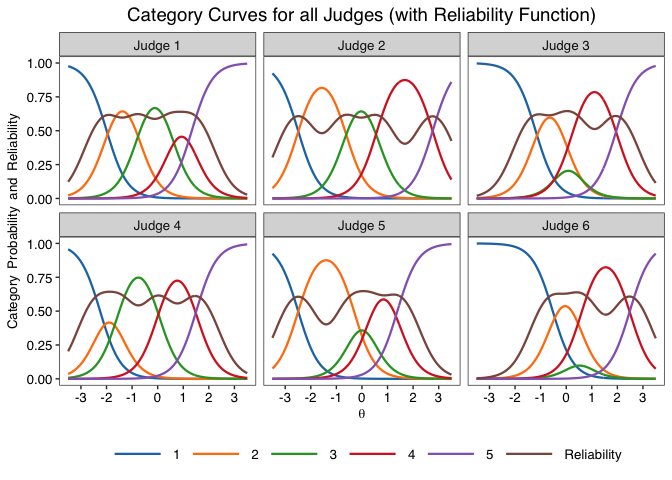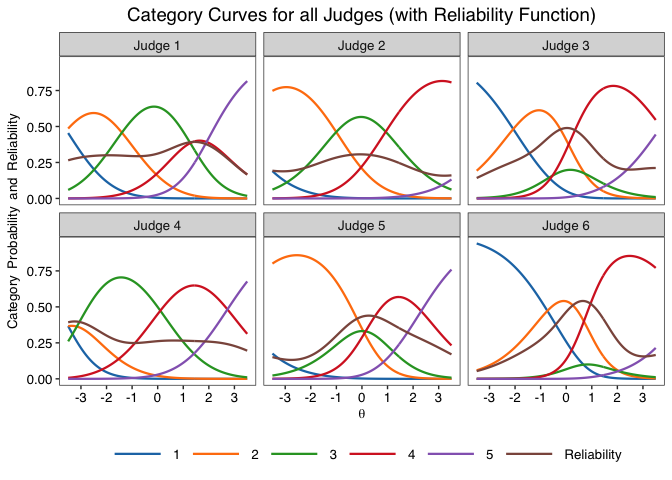

The hardware and bandwidth for this mirror is donated by METANET, the Webhosting and Full Service-Cloud Provider.
If you wish to report a bug, or if you are interested in having us mirror your free-software or open-source project, please feel free to contact us at mirror[@]metanet.ch.
The goal of jrt is to provide tools to use Item-Response Theory (IRT) models on judgment data, especially in the context of the Consensual Assessment Technique, as presented in Myszkowski (2021).
You can install the released version of jrt from CRAN with:
install.packages("jrt")library(jrt)
#> Loading required package: directlabelsdata <- jrt::ratingsfit <- jrt(data, progress.bar = F)
#> The possible responses detected are: 1-2-3-4-5
#>
#> -== Model Selection (6 judges) ==-
#> AIC for Rating Scale Model: 4414.163 | Model weight: 0.000
#> AIC for Generalized Rating Scale Model: 4368.776 | Model weight: 0.000
#> AIC for Partial Credit Model: 4022.956 | Model weight: 0.000
#> AIC for Generalized Partial Credit Model: 4014.652 | Model weight: 0.000
#> AIC for Constrained Graded Rating Scale Model: 4399.791 | Model weight: 0.000
#> AIC for Graded Rating Scale Model: 4308.616 | Model weight: 0.000
#> AIC for Constrained Graded Response Model: 3999.248 | Model weight: 0.673
#> AIC for Graded Response Model: 4000.689 | Model weight: 0.327
#> -> The best fitting model is the Constrained Graded Response Model.
#>
#> -== General Summary ==-
#> - 6 Judges
#> - 300 Products
#> - 5 response categories (1-2-3-4-5)
#> - Mean judgment = 2.977 | SD = 0.862
#>
#> -== IRT Summary ==-
#> - Model: Constrained (equal slopes) Graded Response Model (Samejima, 1969) | doi: 10.1007/BF03372160
#> - Estimation package: mirt (Chalmers, 2012) | doi: 10.18637/jss.v048.i06
#> - Estimation algorithm: Expectation-Maximization (EM; Bock & Atkin, 1981) | doi: 10.1007/BF02293801
#> - Method of factor scoring: Expected A Posteriori (EAP)
#> - AIC = 3999.248 | AICc = 4003.993 | BIC = 4091.843 | SABIC = 3999.248
#>
#> -== Model-based reliability ==-
#> - Empirical reliability | Average in the sample: .893
#> - Expected reliability | Assumes a Normal(0,1) prior density: .894

fit <- jrt(data, irt.model = "PCM")
#> The possible responses detected are: 1-2-3-4-5
#>
#> -== General Summary ==-
#> - 6 Judges
#> - 300 Products
#> - 5 response categories (1-2-3-4-5)
#> - Mean judgment = 2.977 | SD = 0.862
#>
#> -== IRT Summary ==-
#> - Model: Partial Credit Model (Masters, 1982) | doi: 10.1007/BF02296272
#> - Estimation package: mirt (Chalmers, 2012) | doi: 10.18637/jss.v048.i06
#> - Estimation algorithm: Expectation-Maximization (EM; Bock & Atkin, 1981) | doi: 10.1007/BF02293801
#> - Method of factor scoring: Expected A Posteriori (EAP)
#> - AIC = 4022.956 | AICc = 4027.701 | BIC = 4115.551 | SABIC = 4022.956
#>
#> -== Model-based reliability ==-
#> - Empirical reliability | Average in the sample: .889
#> - Expected reliability | Assumes a Normal(0,1) prior density: .759

jcc.plot(fit)
jcc.plot(fit, judge = 1)
jcc.plot(fit, judge = 1, overlay.reliability = T, greyscale = T, theme = "classic")
info.plot(fit)
info.plot(fit, judge = 1)
info.plot(fit, type = "Reliability",
y.line = .70,
y.limits = c(0,1),
theta.span = 4,
theme = "classic")
These binaries (installable software) and packages are in development.
They may not be fully stable and should be used with caution. We make no claims about them.